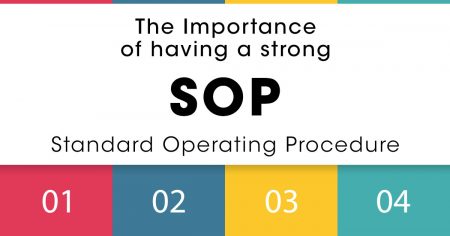The Importance of Having a Strong Standard Operating Procedure (SOP)


What is a Standard Operating Procedure (SOP)?
SOP stands for Standard Operating Procedure, a set of step-by-step instructions compiled and developed by an organization to help employees carry out routine operations. The purpose of an SOP is to ensure that operations are performed consistently and correctly, reducing variability and ensuring quality and efficiency across the board. SOPs are essential in maintaining consistency, meeting regulatory requirements, and enabling training and performance evaluation.
Why are SOPs ImportantWhat are the benefits of standard operating procedures?
Every company needs a solid SOP. While it might not apply to every job function, a well-crafted SOP ensures smoother operations across the board. It provides each team member with a clear understanding of how tasks flow, eliminating guesswork and enhancing job performance. When everyone knows their role and the steps they need to take, work becomes more efficient, reducing delays and improving overall productivity.
Meeting Client Expectations
Clients expect consistent quality, and maintaining that standard is crucial for building trust and long-term relationships. A robust SOP minimizes errors and variations, ensuring that the products or services you deliver meet client expectations every time. Reliability is key to reducing risks for your clients, and when roles and responsibilities are clearly defined, issues can be quickly identified and corrected. This clarity not only improves quality but also empowers employees to take ownership of their work, leading to higher productivity and more accurate performance evaluations.
Scaling and Flexibility
As your company grows, a finely tuned SOP will enable quick replication and scaling of successful processes. It acts as a blueprint for expansion, ensuring that new locations or teams can operate at the same standard as your original operations. Conversely, during times of downsizing or restructuring, an SOP helps identify areas where cuts can be made with minimal disruption. In multi-location operations, the success of the business often hinges on a strong SOP, as it provides consistency across different sites. For instance, if a key team member goes on a long vacation, a clear SOP allows their substitute to seamlessly step in, ensuring that operations continue smoothly without compromising quality or efficiency.
Save Brainpower for Innovation
Instead of constantly trying to figure out an effective flow and process for every task, dedicate your mental energy to creativity, tackling new challenges, and coming up with ways to help the company grow. A strong, well-planned SOP frees up you and your team, so can focus on innovation and strategic thinking, driving the company forward.
How to Building a Strong SOP
Creating an effective SOP requires a thoughtful process that involves several key steps. Here are some pointers to remember on how to develop standard operating procedures:
1. Understand the Workflow
Start by mapping out the entire workflow for each job function. Document every step, from start to finish, to ensure no detail is overlooked. This thorough understanding is crucial because the SOP needs to reflect the actual day-to-day operations.
2. Identify and Collaborate with Stakeholders
Identify all key stakeholders involved in the process, including employees who perform the tasks, managers who oversee operations, and any external parties affected by the SOP. Engage these stakeholders early in the process to gather diverse perspectives and ensure that the SOP meets the needs of everyone involved. By working closely with team members and other stakeholders, you can make the SOP both practical and realistic, reflecting the nuances of each role and fostering a sense of ownership among employees.
3. Define Clear Objectives
Each section of the SOP should be linked to specific objectives, whether it’s improving efficiency, reducing errors, or maintaining consistency. Clear objectives will guide the structure of the SOP and ensure it remains focused and relevant to your business goals.
4. Use Simple and Direct Language
The language used in an SOP should be clear, concise, and easy to understand. Avoid jargon and overly complex terms that could confuse employees. The goal is to make the SOP accessible to everyone, regardless of their experience level, so that it can be followed accurately and consistently.
5. Incorporate Visual Aids
Where applicable, use diagrams, flowcharts, or checklists to visually represent steps in the process. Visual aids can make the SOP easier to follow, particularly for complex tasks, and can be especially helpful for visual learners.
6. Pilot Testing
Before finalizing the SOP, conduct a pilot test with a small group of employees. This allows you to identify any gaps or issues in the procedure that were not initially apparent. Feedback from this test phase is invaluable for refining the SOP and ensuring that it works as intended in real-world scenarios.
7. Revise and Refine
Based on the feedback from the pilot test, make necessary adjustments. An SOP should be a living document, open to revisions as processes evolve or new information comes to light. Regular reviews ensure that the SOP remains relevant and effective, adapting to changes in the business environment.
8. Training and Implementation
Once the SOP is finalized, conduct comprehensive training sessions for all relevant employees. It’s crucial that everyone understands the procedures and knows how to apply them in their daily tasks. Proper training ensures that the SOP is implemented consistently across the board, leading to uniformity in operations.
9. Monitor and Adjust
After implementation, continuously monitor the effectiveness of the SOP. Collect data on performance, identify any areas where the SOP may not be working as intended, and make adjustments as needed. This ongoing process of monitoring and refinement keeps the SOP aligned with the company’s goals and operational needs, ensuring long-term success.
10. Encourage Feedback
Create a culture where employees feel comfortable providing feedback on the SOP. Their insights can be instrumental in identifying areas for improvement. Encourage them to speak up when they encounter issues or have ideas for making the SOP more effective, fostering continuous improvement and employee engagement.
Standard Operating Procedure Example
Below are some examples of the most common SOP formats: step-by-step standard operating procedure, standard operating procedure flow chart, and standard operating procedure checklist.
Step-by-Step SOP
A Step-by-Step SOP is a detailed guide that outlines each task in a process sequentially. It’s designed to be straightforward, guiding users through every action they need to take, often with precise instructions. This type of SOP is ideal for processes that require exact execution, ensuring consistency and reducing the chance of errors.

Standard operating procedure example of a step-by-step SOP from HubSpot.com
Standard Operating Procedure Flowchart
An SOP Flowchart visually represents a process, showing the steps in a diagrammatic form. It uses shapes, arrows, and lines to illustrate the flow of tasks, decisions, and actions. Flowcharts are excellent for simplifying complex processes, allowing users to quickly grasp the sequence of operations and decision points.

Standard operating procedure example of a flow chart SOP from Zapier.com
Standard Operating Procedure Checklist
A standard operating procedure checklist is a list of tasks that need to be completed in a particular process. It’s a straightforward tool that allows users to check off each task as they complete it, ensuring that no steps are missed. Checklists are ideal for routine procedures where consistency and thoroughness are critical, making them easy to follow and verify.

Standard operating procedure example of a checklist SOP from Marker.io
For more information on the benefits of standard operating procedures and how our SOP can ensure the timely delivery of your project, consult with us by submitting the form below:
Contact Us
DROP US A MESSAGE
WE'LL GET BACK TO YOU SOON!



